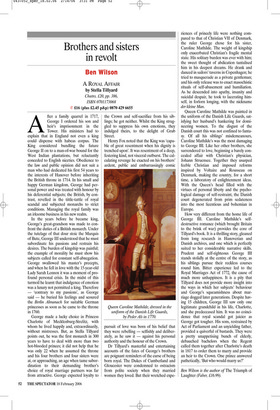Brothers and sisters in revolt
Ben Wilson
A ROYAL AFFAIR by Stella Tillyard Chatto, £20, pp. 386, ISBN 0701173068 ✆ £16 (plus £2.45 p&p) 0870 429 6655 After a family quarrel in 1717, George I ordered his son and heir’s imprisonment in the Tower. His ministers had to explain that in England not even a king could dispense with habeas corpus. The King considered bundling the future George II on to a man-of-war bound for the West Indian plantations, but reluctantly conceded to English niceties. Obedience to the law and public opinion did not suit a man who had dedicated his first 54 years to the interests of Hanover before inheriting the British throne in 1714. In his small and happy German kingdom, George had personal power and was treated with honour by his deferential subjects; the British, by contrast, revelled in the tittle-tattle of royal scandal and subjected monarchs to strict conditions. Managing the royal family was an irksome business in his new realm.
In the years before he became king, George’s great-grandson was made to confront the duties of a British monarch. Under the tutelage of that dour stoic the Marquis of Bute, George III understood that he must subordinate his passions and restrain his desires. The burden of kingship was painful; the example of morality he must show his subjects called for constant self-abnegation. George swallowed his master’s precepts, and when he fell in love with the 15-year-old Lady Sarah Lennox it was a moment of profound personal crisis. In the midst of this turmoil he learnt that indulgence of emotion was a luxury not permitted a king. Therefore — ‘contrary to my passions’, as George said — he buried his feelings and scoured the Berlin Almanach for suitable German princesses as soon as he came to the throne in 1760.
George made a lucky choice in Princess Charlotte of Mecklenburg-Strelitz, with whom he lived happily and, extraordinarily, without mistresses. But, as Stella Tillyard points out, he was the first monarch in 300 years to have to deal with more than two hot-blooded princes; it did not help that he was only 22 when he assumed the throne and his four brothers and four sisters were at, or approaching, an age when tame subordination to their demanding brother’s choice of royal marriage partners was far from attractive. George expected loyalty to the Crown and self-sacrifice from his siblings; he got neither. Whilst the King struggled to suppress his own emotions, they indulged theirs, to the delight of Grub Street.
Henry Fox noted that the King was ‘capable of great resentment when his dignity is trenched upon’. It was resentment of a deep, festering kind, not visceral outburst. The calculating revenge he exacted on his brothers’ ardent, public and embarrassingly comic pursuit of love was born of his belief that they were rebelling — selfishly and deliberately, as he saw it — against his personal authority and the honour of the Crown.
Dr Tillyard’s masterful and entertaining accounts of the fates of George’s brothers are poignant reminders of the curse of being born royal. The Dukes of Cumberland and Gloucester were condemned to ostracism from polite society when they married women they loved. But their wretched expe riences of princely life were nothing compared to that of Christian VII of Denmark, the ruler George chose for his sister, Caroline Mathilde. The weight of kingship only exacerbated Christian’s fragile mental state. His solitary burden was ever with him; the sweet thought of abdication tantalised him in his deepest dreams. He drank and danced in sailors’ taverns in Copenhagen; he tried to masquerade as a private gentleman; and his only release was to enact masochistic rituals of self-abasement and humiliation. As he descended into apathy, insanity and suicidal despair, he took to lacerating himself, in forlorn longing, with the nickname der kleine Man.
Queen Caroline Mathilde was painted in the uniform of the Danish Life Guards, satisfying her husband’s hankering for domineering women. To the disgust of the Danish court this was not confined to fantasy. Of all his siblings’ misdemeanours, Caroline Mathilde’s was the most damaging to George III. Like her other brothers, she surrendered to love, beginning a barely concealed affair with Christian’s physician, Johann Struensee. Together they usurped feeble Christian and imposed reforms inspired by Voltaire and Rousseau on Denmark, making the country, for a short time, a laboratory of enlightenment ideas. With the Queen’s head filled with the virtues of personal liberty and the psychological damage of self-restraint, the Danish court degenerated from prim sedateness into the most licentious and bohemian in Europe.
How very different from the home life of George III. Caroline Mathilde’s selfdestructive romance (which brought Britain to the brink of war) provides the core of Tillyard’s book. It is a thrilling story, gleaned from long research in Hanoverian and Danish archives, and one which is perfectly suited to her considerable narrative skills. Prudent and self-righteous George III stands stolidly at the centre of the story, as his siblings pursue their reckless courses round him. Bitter experience led to the Royal Marriages Act of 1772, the cause of much more unhappiness. It is a pity that Tillyard does not provide more insight into the ways in which her subjects’ behaviour and George’s squeamishness about marriage dogged later generations. Despite having 15 children, George III saw only one legitimate grandchild in his life, Charlotte, and she predeceased him. It was no coincidence that royal scandal got juicier as George got tougher. His sons, restrained by Act of Parliament and an unyielding father, provided a quiverful of bastards. They were a pretty unappetising bunch of elderly, debauched bachelors when the Regent called them together after Charlotte’s death in 1817 to order them to marry and provide an heir to the Crown. One prince answered pathetically, ‘But who would marry us?’


















































































 Previous page
Previous page